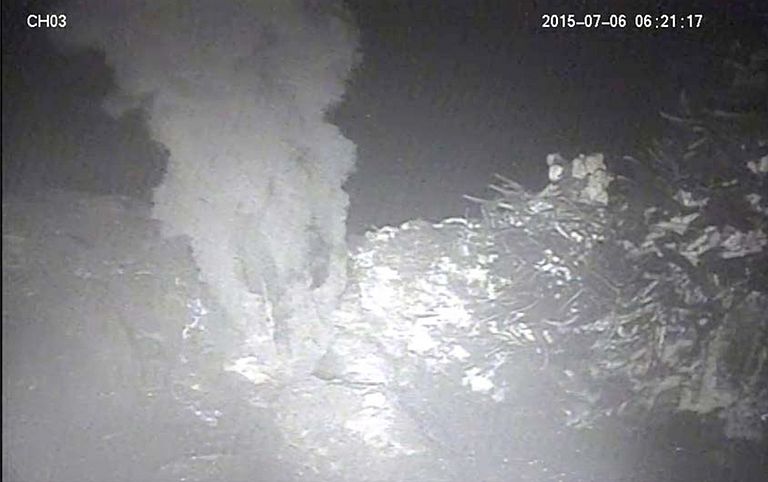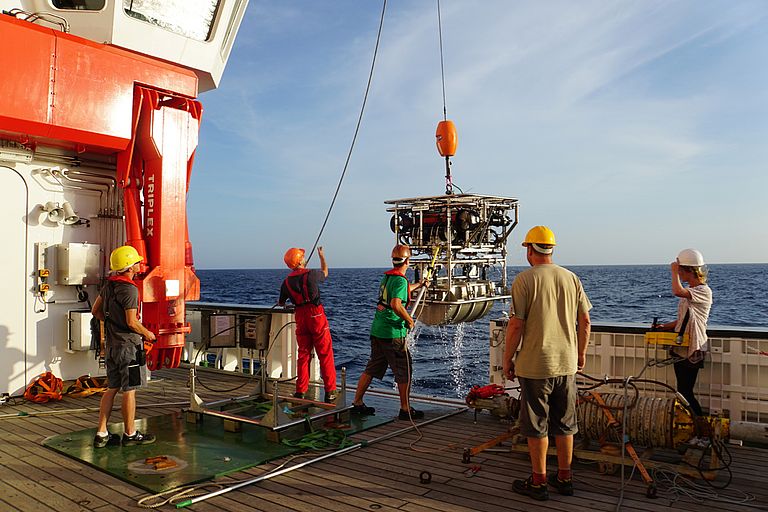Discovery of a large hot vent site in the Gulf of California
Fascinating results of cruise SO241 with Germany’s new research vessel SONNE
Reliable climate forecasts are only possible if all the factors that affect the climate are known. Therefore it is necessary to find out what caused global warmings in the past. One hypothesis is, for example, that increased volcanic activity during the widening of the North Atlantic triggered a rapid warming, the so-called Paleocene Eocene Thermal Maximum (PETM), 54 Million years ago. A research team from Germany, Mexico, Switzerland, Norway currently conducts a cruise on the German vessel SONNE in the Guaymas Basin in the Gulf of California to test this hypothesis. The Guaymas Basin is thought to be in a similar state of rifting as the North Atlantic at the end of the Paleocene.
While investigating the seafloor the team now has discovered a vent field with several black smokers of unusual size at an unexpected place. “This is a major discovery, because it changes our views on how carbon is emitted from sedimentary basins. This will have profound consequences for the assessment of the relevance of magmatic systems in the Earth system”, explains Christian Berndt, geophysicist at GEOMAR Helmholtz Centre for Ocean Research Kiel and chief scientist of cruise SO241.
During the opening of a new ocean there is a phase when the splitting of the continental crust has unloaded the hot mantle of the Earth so much that volcanism starts. The magmatic rocks intrude into the remaining sediments where they boil up the pore water and liberate large amounts of carbon that was buried along with the sediments. The carbon rich pore water then begins to migrate to the surface under its own buoyancy.
As such systems were wide spread during the opening of the North Atlantic 54 million years ago it has been proposed that they were responsible for the intense global warming known today as PETM. So far it was unclear how vigorous these systems were and what kind of carbon compounds they have emitted. The Guaymas Basin in the Gulf of California might provide answers to these questions as it is presently opening and the first volcanic intrusions into the basin have already occurred.
Based on regional seismic data and echosounder data the team identified potential sites for fluid expulsion. These sites were then inspected more closely using the underwater robot HYBIS. Already on its first dive a new vent field was discovered which is characterized by venting of hot fluids that immediately precipitate minerals when they mix with the cold sea water. The hot fluids are rich in methane that is injected high into the water column. The vent field is about 500 meter long and consists of at least four up to 70 m high mounds.
“This phenomenon was previously known from black smokers at mid ocean ridges. A field of this size aside the spreading axis is very unusual”, says Professor Berndt. The size and activity of the system is supporting the idea that hydrothermal venting may indeed be of relevance for global climate when it occurs on larger scale during the opening of big ocean basins.
Christian Hensen, a geochemist with GEOMAR, points out that the fluids carry a mixed signal of magmatic systems and sedimentary systems which is precisely what is expected from hydrothermal activity caused by sill intrusions. The magmatic origin is also indicated by high helium concentrations in the water column. The measuremnts were carried out by colleagues from the Swiss institute of water research EAWAG.
“Of course we only got first impressions. Now we have to analyze the samples and data obtained at the vents in the labs at home. But I’m sure we will get fascinating results”, says Professor Berndt. RV SONNE will dock in Guayaquil (Ecuador) on 24 July.
High-resolution images:
A Black Smooker in the Guaymas Basin. Photo: ROV HYBIS, GEOMAR
ROV HYBIS returns to the deck of RV SONNE with samples and images from the deep. Poto: Jens Karstens, GEOMAR
Contact:
Jan Steffen (GEOMAR, Communication & Media), Tel: +49 431 600-2811, presse(at)geomar.de




